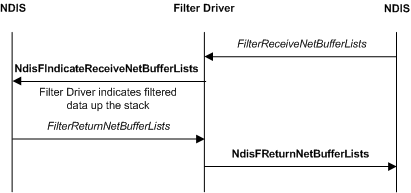Receiving Data in a Filter Driver
Filter drivers can initiate receive indications or filter receive indications from underlying drivers. When a miniport driver calls the NdisMIndicateReceiveNetBufferLists function, NDIS submits the specified NET_BUFFER_LIST structure to the lowest overlying filter module in the driver stack.
Receive Indications Initiated by a Filter Driver
The following figure illustrates a receive indication that is initiated by a filter driver.

Filter drivers call the NdisFIndicateReceiveNetBufferLists function to indicate received data. The NdisFIndicateReceiveNetBufferLists function passes the indicated list of NET_BUFFER_LIST structures up the stack to overlying drivers. The filter driver allocates the structures from pools that it created during initialization.
If a filter driver sets the NDIS_RECEIVE_FLAGS_RESOURCES flag in the ReceiveFlags parameter of NdisFIndicateReceiveNetBufferLists, this indicates that the filter driver must regain ownership of the NET_BUFFER_LIST structures immediately. In this case, NDIS does not call the filter driver's FilterReturnNetBufferLists function to return the NET_BUFFER_LIST structures. The filter driver regains ownership immediately after NdisFIndicateReceiveNetBufferLists returns.
If a filter driver does not set the NDIS_RECEIVE_FLAGS_RESOURCES flag in the ReceiveFlags parameter of NdisFIndicateReceiveNetBufferLists, NDIS returns the indicated NET_BUFFER_LIST structures to the filter driver's FilterReturnNetBufferLists function. In this case, the filter driver relinquishes ownership of the indicated structures until NDIS returns them to FilterReturnNetBufferLists.
Note A filter driver should keep track of receive indications that it initiates and make sure that it does not call the NdisFReturnNetBufferLists function when the receive operation is complete.
Filtering Receive Indications
The following figure illustrates a filtered receive indication that is initiated by an underlying driver.

NDIS calls a filter driver's FilterReceiveNetBufferLists function to process receive indications that come from underlying drivers. NDIS calls FilterReceiveNetBufferLists after an underlying driver calls a receive indication function (for example, NdisMIndicateReceiveNetBufferLists) to indicate received network data or loopback data.
If the NDIS_RECEIVE_FLAGS_RESOURCES flag in the ReceiveFlags parameter of FilterReceiveNetBufferLists is not set, the filter driver keeps ownership of the NET_BUFFER_LIST structures until it calls the NdisFReturnNetBufferLists function.
If the NDIS_RECEIVE_FLAGS_RESOURCES flag in the ReceiveFlags parameter is set, the filter driver cannot keep the NET_BUFFER_LIST structure and the associated underlying driver-allocated resources. This flag can indicate that the underlying driver is running low on receive resources. The FilterReceiveNetBufferLists function should return as quickly as possible.
Note If the NDIS_RECEIVE_FLAGS_RESOURCES flag is set, the filter driver must retain the original set of NET_BUFFER_LIST structures in the linked list. For example, when this flag is set, the driver might process the structures and indicate them up the stack one at a time but before the function returns, it must restore the original linked list.
Filter drivers can perform filter operations on received data before indicating the data to overlying drivers. For each buffer submitted to its FilterReceiveNetBufferLists function a filter driver can do the following:
Pass it on to the next overlying driver by calling NdisFIndicateReceiveNetBufferLists. The driver can modify the contents of the buffer. NDIS guarantees the availability of context space (see NET_BUFFER_LIST_CONTEXT structure).
A filter driver can change the status that NDIS passed to FilterReceiveNetBufferLists or simply pass it on to NdisFIndicateReceiveNetBufferLists.
Note A filter driver can pass on a buffer with NdisFIndicateReceiveNetBufferLists even if NDIS sets the NDIS_RECEIVE_FLAGS_RESOURCES flag in the ReceiveFlags parameter of FilterReceiveNetBufferLists. In this case, the filter driver must not return from FilterReceiveNetBufferLists until it regains ownership of the buffer.
Discard the buffer. If NDIS cleared the NDIS_RECEIVE_FLAGS_RESOURCES flag in the ReceiveFlags parameter of FilterReceiveNetBufferLists, call the NdisFReturnNetBufferLists function to discard the buffer. If NDIS set the NDIS_RECEIVE_FLAGS_RESOURCES flag in the ReceiveFlags parameter of FilterReceiveNetBufferLists, take no action and return from FilterReceiveNetBufferLists to discard the buffer.
Queue the buffer in a local data structure for later processing. If NDIS set the NDIS_RECEIVE_FLAGS_RESOURCES flag in the ReceiveFlags parameter of FilterReceiveNetBufferLists, the filter driver must create a copy before returning from FilterReceiveNetBufferLists.
Copy the buffer and originate a receive indication with the copy. The receive indication is similar to a filter-driver-initiated receive indication. In this case, the driver must return the original buffer to the underlying driver.
The NdisFIndicateReceiveNetBufferLists function passes the indicated list of NET_BUFFER_LIST structures up the driver stack to overlying drivers. The receive operation proceeds similarly to a filter-driver-initiated receive operation.
If an overlying driver retained ownership of the buffer, NDIS calls the FilterReturnNetBufferLists function for the filter module. In its FilterReturnNetBufferLists function, the filter driver will undo the operations that it performed on the buffer on the receive indication path.
When the lowest layer filter module indicates that it is done with a buffer, NDIS returns the buffer to the miniport driver. If NDIS cleared the NDIS_RECEIVE_FLAGS_RESOURCES flag in the ReceiveFlags parameter of FilterReceiveNetBufferLists, the filter driver calls NdisFReturnNetBufferLists to return the buffer. If NDIS set the NDIS_RECEIVE_FLAGS_RESOURCES flag in the ReceiveFlags parameter of FilterReceiveNetBufferLists, returning from FilterReceiveNetBufferLists returns the buffer.
Feedback
Coming soon: Throughout 2024 we will be phasing out GitHub Issues as the feedback mechanism for content and replacing it with a new feedback system. For more information see: https://aka.ms/ContentUserFeedback.
Submit and view feedback for